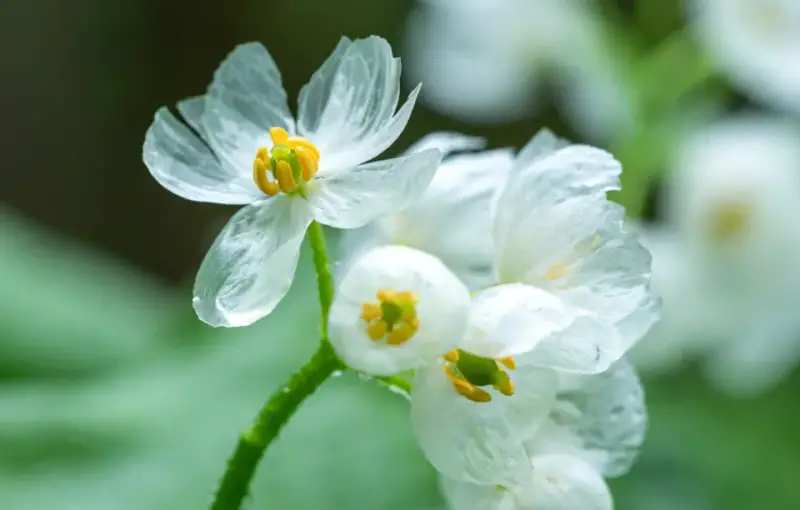Skeleton Flower, scientifically known as Diphylleia grayi, is a rare and fascinating perennial plant known for its translucent petals that turn clear when exposed to water. Native to the cool mountainous regions of Japan, China, and the Appalachian Mountains in the United States, this plant thrives in moist, shaded environments.
This guide will provide detailed insights into how to cultivate and care for Skeleton Flowers successfully.
Understanding Skeleton Flower Characteristics

Appearance
The Skeleton Flower (Diphylleia grayi) is a rare and fascinating plant known for its striking transformation when exposed to water. Its broad, umbrella-like leaves form a dense, green foliage that serves as a stunning contrast to its delicate white flowers. These small, five-petaled blossoms emerge in late spring to early summer, creating an elegant and ethereal display.
One of the most remarkable features of the Skeleton Flower is its petal transparency when wet. Under dry conditions, the petals appear pure white, but upon contact with moisture, they become crystal-clear, resembling glass. This effect occurs due to the unique cellular structure of the petals, which allows water to fill in microscopic spaces and reduce light scattering, giving them their transparent appearance. Once the petals dry, they return to their original white color, making this a truly magical botanical phenomenon.
Natural Habitat
The Skeleton Flower thrives in cool, humid, and shaded environments, making it a common sight in mountainous forests of East Asia, particularly in Japan, China, and Korea. It prefers high-altitude regions where the climate is temperate and consistently moist.
This plant grows best in well-draining, nutrient-rich organic soil, often found in deciduous forests where decomposing leaves provide essential nutrients. It flourishes in areas with dappled sunlight or full shade, as excessive direct sunlight can dry out the delicate petals and hinder its characteristic transparency effect.
Due to its sensitivity to environmental conditions, the Skeleton Flower is a rare find in the wild, but with proper care, it can be cultivated in gardens that mimic its natural habitat, providing a unique and mesmerizing floral display.
How to Grow Skeleton Flower
Choosing the Right Location
Skeleton Flowers require specific environmental conditions to grow successfully, making location selection a crucial step in the planting process.
Shade and Light Requirements
This plant thrives in partial to full shade, mimicking its natural woodland habitat. Direct sunlight should be avoided, as excessive exposure can scorch the leaves and inhibit growth. Ideally, it should be planted under tree canopies, in shaded garden corners, or along the north-facing side of buildings, where it receives only filtered or indirect sunlight.
Soil Requirements
Skeleton Flowers prefer rich, well-draining soil with a high organic content to support healthy root development. The soil should have a slightly acidic to neutral pH, ideally between 5.5 and 7.0.
To improve soil quality, mix in compost, leaf mulch, or well-rotted organic matter, which helps retain moisture while preventing waterlogging. A loose, loamy soil structure works best, ensuring proper aeration and root expansion.
Planting Skeleton Flower
There are two main methods for planting Skeleton Flowers: growing from seeds or planting rhizomes.
From Seeds
- Start indoors during late winter to give seeds enough time to germinate before spring.
- Use a moist, well-draining seed-starting mix in seed trays or small pots.
- Maintain a temperature of 60-70°F (15-21°C) to encourage germination.
- Keep the soil consistently moist but not soggy.
- Transplant seedlings outdoors after the last frost, ensuring they are placed in a shaded, well-prepared garden bed.
From Rhizomes
- Purchase healthy rhizomes from a reliable nursery to ensure strong growth.
- Plant in early spring or fall, when temperatures are cool and humidity is stable.
- Space rhizomes 12-18 inches apart to allow proper root and foliage expansion.
- Cover with 1-2 inches of soil and water thoroughly to establish roots.
- Maintain consistent moisture in the soil, ensuring it remains damp but not waterlogged.
Caring for Skeleton Flower
Watering Needs
Skeleton Flowers require consistently moist soil to thrive, but overwatering should be avoided to prevent root rot. The key is to maintain a damp, well-drained environment that mimics the plant’s natural forest habitat. Water deeply once or twice a week, depending on climate conditions, ensuring the moisture reaches the roots.
Mulching with organic materials such as leaf litter, compost, or bark chips helps retain soil moisture, regulate temperature, and prevent the soil from drying out too quickly. During hot or dry periods, monitor the soil closely and increase watering as needed.
Fertilization
To support healthy growth and flowering, apply a balanced, organic fertilizer in early spring. A slow-release fertilizer or natural amendments like compost, aged manure, or worm castings will provide essential nutrients without overwhelming the plant.
Avoid excessive nitrogen, as it encourages lush foliage at the expense of flower production. A fertilizer with an equal N-P-K ratio or one slightly higher in phosphorus will help promote stronger blooms while maintaining overall plant health.
Pruning and Maintenance
Regular maintenance keeps the Skeleton Flower in optimal condition. Remove dead or damaged leaves to prevent disease and encourage new growth. After flowering, trim back spent blooms to allow the plant to focus its energy on strengthening the rhizomes.
In colder climates, applying a thick layer of mulch in winter helps protect the roots from frost damage. If temperatures drop significantly, consider covering the plant with burlap or a frost cloth to provide additional insulation.
Common Problems and Solutions
Pests
Skeleton Flowers thrive in moist, shaded environments, which can sometimes attract pests like slugs and snails. These pests feed on the leaves, causing holes and damage that can weaken the plant over time. To prevent infestations, apply organic slug repellents such as crushed eggshells or diatomaceous earth around the base of the plant. Hand-picking slugs in the early morning or evening can also help keep their population under control. If the problem persists, consider using pet-safe slug baits or introducing natural predators like frogs and ground beetles into the garden.
Diseases
Fungal diseases, particularly powdery mildew, can develop when the plant is exposed to excessive moisture and poor air circulation. This appears as a white, powdery coating on leaves and stems, potentially weakening the plant and hindering growth. To prevent fungal infections, ensure plants are spaced properly to allow airflow between them. Avoid overhead watering, as wet foliage can encourage fungal growth—watering at the base of the plant is a better option. If mildew does appear, applying a natural fungicide like neem oil or a diluted baking soda solution can help control the spread.
Poor Flowering
Skeleton Flowers require the right balance of shade, moisture, and nutrients to produce their delicate blooms. If the plant is not flowering well, one common cause is excessive sunlight, which can stress the plant and prevent proper bloom development. Ensuring the plant is placed in a shaded or partially shaded location can improve flowering. Additionally, poor soil quality or a lack of nutrients can also lead to weak flower production. Enriching the soil with compost, well-rotted organic matter, or a balanced fertilizer can help provide the necessary nutrients. Keeping the soil consistently moist without becoming waterlogged is also crucial for healthy flowering.
Propagation Methods
Division
One of the easiest and most effective ways to propagate Skeleton Flower is by dividing its rhizomes. This method ensures that new plants establish quickly and maintain the characteristics of the parent plant.
The best time for division is in early spring or fall, when temperatures are cooler and the plant is either emerging from dormancy or preparing for the next growing season. To divide the plant, carefully dig around the rhizomes and lift them from the soil. Gently separate sections, ensuring that each piece has at least one viable bud or growing point. Avoid breaking the rhizomes into pieces that are too small, as they may struggle to establish themselves.
Once divided, replant the sections immediately in well-prepared, moist, and nutrient-rich soil. Water thoroughly after planting to encourage root development. Mulching around the new plants helps retain moisture and provides insulation as they adjust to their new environment.
Seed Propagation
Growing Skeleton Flower from seeds requires patience and specific conditions, as the seeds need cold stratification to break dormancy and germinate successfully.
To stratify the seeds, store them in moist sand or peat moss inside a plastic bag and place them in a refrigerator for 4 to 6 weeks. This process mimics the plant’s natural winter conditions and encourages germination once they are sown.
After stratification, sow the seeds in a moist, well-draining seed-starting mix, ensuring they are lightly covered with soil. Maintain a consistent temperature of 60-70°F (15-21°C) and keep the soil evenly moist. Germination can take several weeks to months, so patience is key. Once seedlings develop a few strong leaves, they can be carefully transplanted into their permanent shaded location outdoors.
Skeleton Flower in Landscaping
Skeleton Flower is a stunning addition to any garden, particularly in shaded and woodland settings where its delicate, transparent blooms can create an enchanting atmosphere. Its ability to turn clear when wet makes it a unique conversation piece, adding a magical touch to the landscape.
This plant thrives in shade gardens, where it pairs beautifully with other shade-loving plants like ferns, hostas, and astilbes. The broad, umbrella-like leaves provide a lush, green backdrop, while the delicate white flowers add elegance and intrigue. Planted in clusters, Skeleton Flower can create a soft, natural look that blends seamlessly into woodland environments.
In gardens with water features, such as ponds, shaded streams, or waterfalls, Skeleton Flower enhances the tranquil ambiance. Its ability to transform when touched by water makes it an excellent choice for areas with high humidity or occasional misting. Placing it near a water source allows visitors to witness its mesmerizing color change effect naturally.
It also works well along shaded pathways or in quiet, meditative garden corners. When positioned along a garden trail or near seating areas, it provides an unexpected and delightful visual experience, inviting closer observation.
Conclusion
Skeleton Flower (Diphylleia grayi) is a mesmerizing addition to any shaded garden. With the right care, including proper soil, consistent moisture, and shade, you can successfully cultivate this rare and enchanting plant. By following this guide, you can enjoy the magic of Skeleton Flowers as they transform with the rain.






